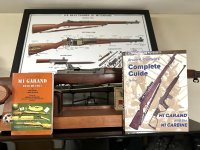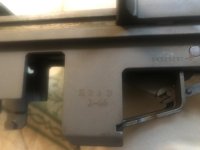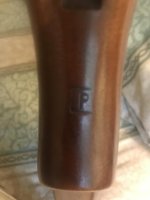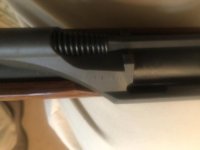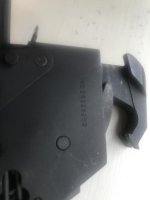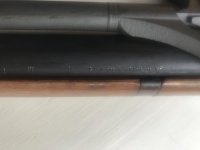My new to me Garand was bought from an old estate sale. It was advertised as authentic matching. The serial number is late 1943 as is the barrel and other parts. The stock looks replaced. It has a P within a square around it and the only other stock marking is what looks like RKAD engraved on the left side of the stock cheek area. Can anyone tell me what I have here especially the stock?
You are using an out of date browser. It may not display this or other websites correctly.
You should upgrade or use an alternative browser.
You should upgrade or use an alternative browser.
Another M1 Garand Question?
- Thread starter AC Man
- Start date
Register to hide this ad
Faulkner
Member
Pictures would be helpful, your description is a little weak on details.
If you really want to confirm if your M1 rifle is indeed "authentic matching" I'd recommend one of several good reference books on them. True original M1 rifles are rare since most of them went through numerous arsenal rebuilds, the stock markings you mention indicate as much.

If you really want to confirm if your M1 rifle is indeed "authentic matching" I'd recommend one of several good reference books on them. True original M1 rifles are rare since most of them went through numerous arsenal rebuilds, the stock markings you mention indicate as much.
Attachments
Last edited:
Look closely at your RKAD marking I have seen RRAD markings in the area you describe. RRAD marks are for the Red River Army Depot. M1,s were rebuilt there in the post WW2 period. A letter P in a square is an arsenal rebuild mark. Therefore your rifle is not all original as it has been rebuilt. Very rare to find all original ones as the M1 was rebuilt into the 1960,s.
OldK22
Member
- Joined
- Feb 2, 2013
- Messages
- 622
- Reaction score
- 1,500
RRAD stamped in the side of the stock is the mark of a rebuild at Red River Army Depot. Is the stock birch or walnut. Pull the stock and see if the receiver legs are etched with a rebuild date. What makes you believe all the "other" parts are from 1943? Most Garands have had parts replaced during their lifetime. People have been "correcting" the rifles as long as they have been available to the public. Meaning that they get a rifle that has been rebuilt with what ever parts were available without regard to manufacturer or time frame. They then disassemble the rifle and replace parts with the "correct" parts to make it like it was originally issued. Getting harder to do unless you have a stash of parts or access to some. Need detailed pictures to help assess what you have.
Look closely at your RKAD marking I have seen RRAD markings in the area you describe. RRAD marks are for the Red River Army Depot. M1,s were rebuilt there in the post WW2 period. A letter P in a square is an arsenal rebuild mark. Therefore your rifle is not all original as it has been rebuilt. Very rare to find all original ones as the M1 was rebuilt into the 1960,s.
Thank you very much. This is what I was looking for. What I thought was a K is an R. It was stamped very lightly and was hard to tell. The receiver and barrel are both late 1943. I was told other mechanical pieces were original as well but still working on that. The stock I knew was not original but had no idea what it was. Very happy to have a answer.
Last edited:
DWalt
Member
Having once owned a number of carbines and Garlands, none were in WWII original condition. The only USGI rifle I have which is original in all respects is an early 1917 Springfield '03.
minconrevo
Member
- Joined
- Feb 14, 2008
- Messages
- 927
- Reaction score
- 843
Very common for M-1 Garands to have gone through at least one, sometimes several, arsenal rebuilds. The rifle was planned to be easily rebuilt and returned to service. Sturdy, practical design it is.
Must see some pics to further help on your M1
Like others posted, some pics, even quicky cell phone pics of key areas are needed to help really identify or value estimate for you.
By posting RRAD you have confirmed that your M1 is a US Army Depot level overhaul, done by US Army Armorers while on active duty.
The US Army Depot level overhaul program for M1 Garands was discontinued in early 1967 because the Depots began the overhaul program for M-14 rifles that had replaced the M1 Garand officially in 1957.
The Red River Army Depot in Texarkana, TX was very active in assembling very high quality M1 Garand overhauls to National Match standards and many of the last ones (1965/1966) went directly to government storage and are sometimes found in a "unfired" since test rebuild condition.
If your stock is VERY TIGHT fit to the receiver (i.e. do you need a trigger guard breaker tool to release the trigger guard from the stock?) AND if your "Box P" proof mark on the pistol grip looks like the pic below, then you definitely have a Red River Army Depot overhaul stock as this was their "proof" mark for the stock. Note that the "box" is really only 3 sides, not 4.
You can see the markings on op rod, barrel dates and proofs, and most important will be the RRAD overhaul date which should show on the receiver leg similar to mine pictured below from January 1966, using a brand new barrel from Springfield Armory, dated August 1965. Hooded rear sight, front sight are NM (National Match) and yours may be too.
Bottom line is that yes the serial number may place your M1 stripped receiver in the WWII era, the barrel date may be different manufacturer and date era, and definitely the rifle was through the Red River Army Depot as some point in its life.
Like others posted, some pics, even quicky cell phone pics of key areas are needed to help really identify or value estimate for you.
By posting RRAD you have confirmed that your M1 is a US Army Depot level overhaul, done by US Army Armorers while on active duty.
The US Army Depot level overhaul program for M1 Garands was discontinued in early 1967 because the Depots began the overhaul program for M-14 rifles that had replaced the M1 Garand officially in 1957.
The Red River Army Depot in Texarkana, TX was very active in assembling very high quality M1 Garand overhauls to National Match standards and many of the last ones (1965/1966) went directly to government storage and are sometimes found in a "unfired" since test rebuild condition.
If your stock is VERY TIGHT fit to the receiver (i.e. do you need a trigger guard breaker tool to release the trigger guard from the stock?) AND if your "Box P" proof mark on the pistol grip looks like the pic below, then you definitely have a Red River Army Depot overhaul stock as this was their "proof" mark for the stock. Note that the "box" is really only 3 sides, not 4.
You can see the markings on op rod, barrel dates and proofs, and most important will be the RRAD overhaul date which should show on the receiver leg similar to mine pictured below from January 1966, using a brand new barrel from Springfield Armory, dated August 1965. Hooded rear sight, front sight are NM (National Match) and yours may be too.
Bottom line is that yes the serial number may place your M1 stripped receiver in the WWII era, the barrel date may be different manufacturer and date era, and definitely the rifle was through the Red River Army Depot as some point in its life.
Attachments
Last edited:
8 years ago I bought M1 Garand from CMP. It is a 1944 WINCHESTER.
very accurate . My good friend who is long range shooter and trained US army artillery units to become short range snipers for IRAQ after the artillery was withdrawn, gave me a fabulous tip on the furniture. Most of the older M1 came with new flat brown stocks. NOT pretty. He said remove furniture and rub it down with double aught sandpaper . Then add coat of TUNG oil, hang up for 24 hours . Then do that again SIX times over SIX days. At the end take emory cloth and lightly rub down again. That stock now looks 3" deep and all the beautiful grain jumps out at you . That $600 gun is now worth $1,200 .
very accurate . My good friend who is long range shooter and trained US army artillery units to become short range snipers for IRAQ after the artillery was withdrawn, gave me a fabulous tip on the furniture. Most of the older M1 came with new flat brown stocks. NOT pretty. He said remove furniture and rub it down with double aught sandpaper . Then add coat of TUNG oil, hang up for 24 hours . Then do that again SIX times over SIX days. At the end take emory cloth and lightly rub down again. That stock now looks 3" deep and all the beautiful grain jumps out at you . That $600 gun is now worth $1,200 .
LVSteve
Member
8 years ago I bought M1 Garand from CMP. It is a 1944 WINCHESTER.
very accurate . My good friend who is long range shooter and trained US army artillery units to become short range snipers for IRAQ after the artillery was withdrawn, gave me a fabulous tip on the furniture. Most of the older M1 came with new flat brown stocks. NOT pretty. He said remove furniture and rub it down with double aught sandpaper . Then add coat of TUNG oil, hang up for 24 hours . Then do that again SIX times over SIX days. At the end take emory cloth and lightly rub down again. That stock now looks 3" deep and all the beautiful grain jumps out at you . That $600 gun is now worth $1,200 .
A bubba'd stock is a bubba'd stock to a true military collector. Your gun, your choice if you want it pretty. I prefer my milsurps military looking.
Richard Simmons
Member
Pertaining to the comments above regarding tung oil. This is a little different as it involves boiled linseed oil however the old adage I recall was to apply the BLO once a day for a week, once a week for a month then once a month for a year. I may have made it through a month but a year used to be a long time!
The trigger housing of the OP's Garand has a prefix of "IHC." International Harvester produced Garands post WWII. I have a Garand from the DCM days that has a complete trigger group that is IHC along with a 54' dated barrel by LMR and a NM (new model) op rod that was rebuilt at RRA. The receiver is a SA with a WWII serial number but, the rifle looks "new."
My cost was less than $130.00 in 1982 shipped to my door and it shoots great!
My cost was less than $130.00 in 1982 shipped to my door and it shoots great!
Similar threads
- Replies
- 6
- Views
- 3K
- Replies
- 3
- Views
- 1K
- Replies
- 37
- Views
- 2K

